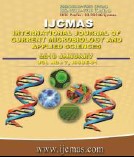


 National Academy of Agricultural Sciences (NAAS)
National Academy of Agricultural Sciences (NAAS)

|
PRINT ISSN : 2319-7692
Online ISSN : 2319-7706 Issues : 12 per year Publisher : Excellent Publishers Email : editorijcmas@gmail.com / submit@ijcmas.com Editor-in-chief: Dr.M.Prakash Index Copernicus ICV 2018: 95.39 NAAS RATING 2020: 5.38 |
A field experiment was conducted at Indian Agricultural Research Institute, New Delhi during rabi seasons of 2014-15 and 2015-16 to assess the effect of tillage, crop residues and nitrogen management on growth performance and soil microbial parameters in wheat under soybean-wheat cropping system. The experiment was laid out in split plot design with 4 tillage and residue management practices viz., Zero tillage without residue (ZT- R), zero tillage with soybean residue (ZT+SR), zero tillage with soybean residue and residual effect of preceding wheat residue (ZT+SWR) and conventional tillage without residue (CT- R) in main plots and 4 nitrogen management practices viz., 100% recommended dose of nitrogen (RDN) as basal (N1), 125% RDN as basal (N2), 100% basal + 25% top dressing (N3) and 75 % basal + 25% top dressing (N4) in sub plots. The results revealed that the growth parameters of wheat and soil microbial activity were significantly improved with zero tillage & residue retention. Maximum plant height, LAI and dry matter accumulation (DMA) were observed with ZT+SWR and it was on par with ZT+SR and significantly superior to other treatments. Among the no residue treatments, CT - R gave maximum values of growth attributes but was statistically at par with ZT−R. ZT+SWR recorded 16.5 % and 25.9 % higher microbial biomass carbon than ZT-R and CT-R respectively. Among the nitrogen management practices, the maximum plant height, LAI, DMA, physiological indices and improved soil microbial parameters were reported with N2 which was found statistically at par with N1 and significantly superior to rest of the treatments. It is concluded that application of 25% higher N over the recommended dose either as basal or as top dressing along with zero tillage plus crop residue could give better growth performance and improved soil microbial properties in wheat.
 |
 |
 |
 |
 |